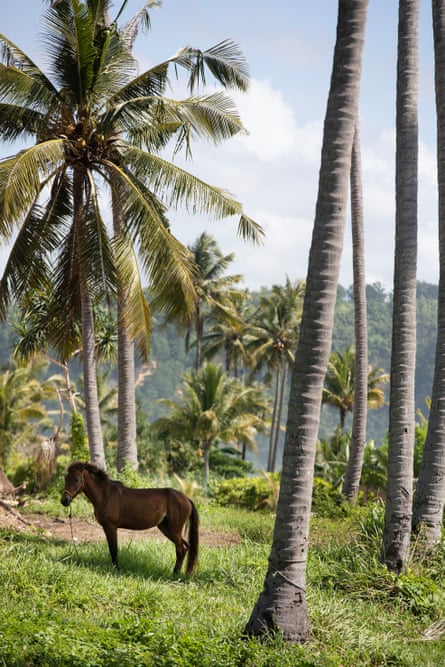On the parched plains of Sumba, a remote island in Indonesia’s eastern archipelago, a breed of hardy ponies plays a vital role in the lives of the local people.
Known as sandalwood ponies, these small, resilient horses are more than just working animals – they are cultural symbols, markers of status, and increasingly, a draw for tourists eager to experience the island’s untouched landscapes and traditions.

-
Gerson swimming horses, West Sumba regency, Nusa Tenggara
“Horses are intertwined with our way of life here,” said Gerson, a horse caretaker at a luxury hotel in Sumba. “They’re used for everything – transport, carrying crops, but most importantly, for ceremonies and traditions.”
Sumba, known for its ancient megalithic tombs and intricate ikat textiles, has long been off the beaten path for most tourists. However, in recent years, adventurous travellers have started flocking to the island, drawn by its rugged beauty and cultural heritage.

Among the unique attractions is the opportunity to explore the island on horseback, riding the distinctive sandalwood ponies through rolling hills and along secluded beaches.
The sandalwood ponies, smaller and more robust than mainland horses, are believed to be descendants of Mongolian horses brought to the island centuries ago.

-
A man takes his Sumba ponies for a swim to cool off from the tropical heat.
Their name comes from the island’s once-abundant sandalwood trees, a valuable resource that was historically traded across south-east Asia. The ponies, known for their endurance, have adapted well to Sumba’s harsh terrain and are highly prized in the local community.
The sandalwood ponies hold significant cultural value for the Sumbanese, particularly in traditional ceremonies such as weddings and funerals. One of the most important events in Sumbanese culture is the annual pasola, a ritual spear-throwing competition that takes place every February and March, coinciding with the rice planting season.

The pasola is both a sport and a spiritual event, rooted in the island’s Marapu religion. During the festival, two teams of horsemen engage in mock battles, galloping across open fields while hurling spears at their opponents. The spectacle draws large crowds, and for the Sumbanese, the event is believed to ensure a bountiful harvest.

-
A Sumba man sits at the front of his traditionally built home in West Sumba regency, Nusa Tenggara.
The spilling of blood – human or horse – is considered a sign of good fortune for the upcoming agricultural season.
Despite their cultural importance, the number of sandalwood ponies on the island has been in decline in recent years. Economic pressures and the influence of modern life have made it increasingly difficult for families to maintain their herds.
Crossbreeding with larger, imported horses, especially for racing purposes, is also threatening the genetic purity of the breed.

“It’s becoming harder for families to afford them,” said Gerson, who goes by one name. “Fewer young people are learning how to care for the horses, and the demand for faster racing horses is affecting the local breeds.”
According to Robertus Fahik, a writer and expert on Sumba, horses are crucial in Sumba’s customary marriage practices, particularly in the tradition of Belis, the ceremonial bride price.

-
A man washes his Sumba pony in the sea, while children play and look for seafood on the reef at low tide.
“In Belis, families are required to provide livestock, including horses, as part of the dowry,” he said. “Every horse in Sumba is meticulously documented, almost like having an identity card.”
Horses also play a symbolic role in transporting souls to the afterlife, according to Fahik. “When someone dies, there’s a practice called padang where a horse or another animal is sacrificed, believed to accompany the spirit of the deceased,” Fahik said.

In Sumbanese culture, a galloping stallion and a crowing rooster are metaphors for leadership and authority, he said. “The horse symbolises a strong leader, while the rooster, with its crow, stands for someone who commands respect and guidance.”
Tourism offers a potential lifeline for the island’s traditions and its prized ponies, as horseback tours become more and more popular.
“Tourism can help preserve our heritage,” Gerson said. “The more people learn about our traditions, the more they’ll support our efforts to keep them alive.”
